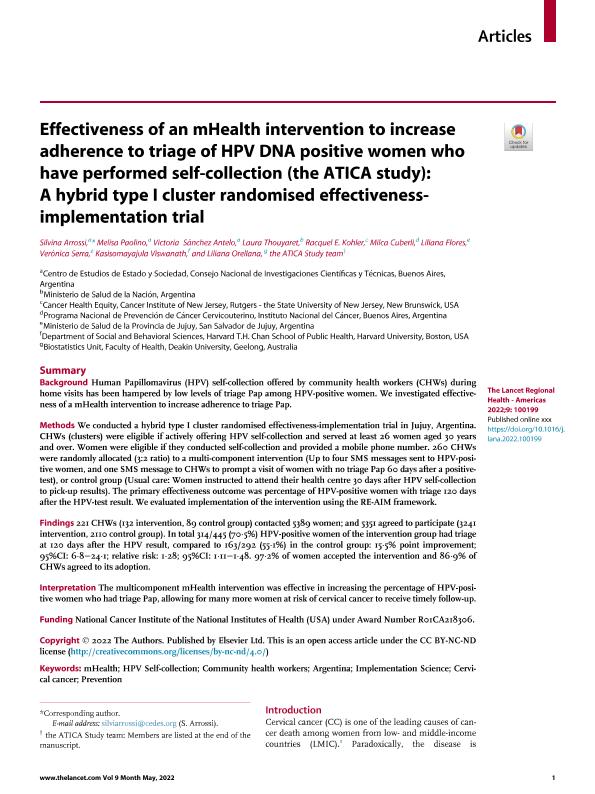Mostrar el registro sencillo del ítem
dc.contributor.author
Arrossi, Silvina

dc.contributor.author
Paolino, Melisa Delia

dc.contributor.author
Sánchez Antelo, Victoria Inés María

dc.contributor.author
Thouyaret, Laura

dc.contributor.author
Kohler, Racquel

dc.contributor.author
Cuberli, Milca
dc.contributor.author
Flores, Liliana
dc.contributor.author
Serra, Verónica
dc.contributor.author
Viswanath, Kasisomayajula

dc.contributor.author
Orellana, Liliana

dc.date.available
2024-01-03T09:59:59Z
dc.date.issued
2022-05
dc.identifier.citation
Arrossi, Silvina; Paolino, Melisa Delia; Sánchez Antelo, Victoria Inés María; Thouyaret, Laura; Kohler, Racquel; et al.; Effectiveness of an mHealth intervention to increase adherence to triage of HPV DNA positive women who have performed self-collection (the ATICA study): A hybrid type I cluster randomised effectiveness-implementation trial; Elsevier; The Lancet Regional Health - Americas; 9; 100199; 5-2022; 1-18
dc.identifier.issn
2667-193X
dc.identifier.uri
http://hdl.handle.net/11336/222102
dc.description.abstract
Background: Human Papillomavirus (HPV) self-collection offered by community health workers (CHWs) during home visits has been hampered by low levels of triage Pap among HPV-positive women. We investigated effectiveness of a mHealth intervention to increase adherence to triage Pap. Methods: We conducted a hybrid type I cluster randomised effectiveness-implementation trial in Jujuy, Argentina. CHWs (clusters) were eligible if actively offering HPV self-collection and served at least 26 women aged 30 years and over. Women were eligible if they conducted self-collection and provided a mobile phone number. 260 CHWs were randomly allocated (3:2 ratio) to a multi-component intervention (Up to four SMS messages sent to HPV-positive women, and one SMS message to CHWs to prompt a visit of women with no triage Pap 60 days after a positive-test), or control group (Usual care: Women instructed to attend their health centre 30 days after HPV self-collection to pick-up results). The primary effectiveness outcome was percentage of HPV-positive women with triage 120 days after the HPV-test result. We evaluated implementation of the intervention using the RE-AIM framework. Findings: 221 CHWs (132 intervention, 89 control group) contacted 5389 women; and 5351 agreed to participate (3241 intervention, 2110 control group). In total 314/445 (70·5%) HPV-positive women of the intervention group had triage at 120 days after the HPV result, compared to 163/292 (55·1%) in the control group: 15·5% point improvement; 95%CI: 6·8–24·1; relative risk: 1·28; 95%CI: 1·11–1·48. 97·2% of women accepted the intervention and 86·9% of CHWs agreed to its adoption. Interpretation: The multicomponent mHealth intervention was effective in increasing the percentage of HPV-positive women who had triage Pap, allowing for many more women at risk of cervical cancer to receive timely follow-up. Funding: National Cancer Institute of the National Institutes of Health (USA) under Award Number R01CA218306.
dc.format
application/pdf
dc.language.iso
eng
dc.publisher
Elsevier

dc.rights
info:eu-repo/semantics/openAccess
dc.rights.uri
https://creativecommons.org/licenses/by-nc-nd/2.5/ar/
dc.subject
ARGENTINA
dc.subject
CERVICAL CANCER
dc.subject
COMMUNITY HEALTH WORKERS
dc.subject
HPV SELF-COLLECTION
dc.subject
IMPLEMENTATION SCIENCE
dc.subject
MHEALTH
dc.subject
PREVENTION
dc.subject.classification
Políticas y Servicios de Salud

dc.subject.classification
Ciencias de la Salud

dc.subject.classification
CIENCIAS MÉDICAS Y DE LA SALUD

dc.title
Effectiveness of an mHealth intervention to increase adherence to triage of HPV DNA positive women who have performed self-collection (the ATICA study): A hybrid type I cluster randomised effectiveness-implementation trial
dc.type
info:eu-repo/semantics/article
dc.type
info:ar-repo/semantics/artículo
dc.type
info:eu-repo/semantics/publishedVersion
dc.date.updated
2024-01-02T11:42:22Z
dc.journal.volume
9
dc.journal.number
100199
dc.journal.pagination
1-18
dc.journal.pais
Países Bajos

dc.journal.ciudad
Amsterdam
dc.description.fil
Fil: Arrossi, Silvina. Consejo Nacional de Investigaciones Científicas y Técnicas; Argentina. Centro de Estudio de Estado y Sociedad; Argentina
dc.description.fil
Fil: Paolino, Melisa Delia. Consejo Nacional de Investigaciones Científicas y Técnicas; Argentina. Centro de Estudio de Estado y Sociedad; Argentina
dc.description.fil
Fil: Sánchez Antelo, Victoria Inés María. Consejo Nacional de Investigaciones Científicas y Técnicas; Argentina. Centro de Estudio de Estado y Sociedad; Argentina
dc.description.fil
Fil: Thouyaret, Laura. Ministerio de Salud de la Nación; Argentina
dc.description.fil
Fil: Kohler, Racquel. State University of New Jersey; Estados Unidos
dc.description.fil
Fil: Cuberli, Milca. Instituto Nacional del Cáncer; Argentina
dc.description.fil
Fil: Flores, Liliana. Gobierno de la Provincia de Jujuy. Ministerio de Salud; Argentina
dc.description.fil
Fil: Serra, Verónica. Gobierno de la Provincia de Jujuy. Ministerio de Salud; Argentina
dc.description.fil
Fil: Viswanath, Kasisomayajula. Harvard University. Harvard School of Public Health; Estados Unidos
dc.description.fil
Fil: Orellana, Liliana. Deakin University; Australia
dc.journal.title
The Lancet Regional Health - Americas
dc.relation.alternativeid
info:eu-repo/semantics/altIdentifier/doi/https://doi.org/10.1016/j.lana.2022.100199
dc.relation.alternativeid
info:eu-repo/semantics/altIdentifier/url/https://www.sciencedirect.com/science/article/pii/S2667193X22000163
Archivos asociados
